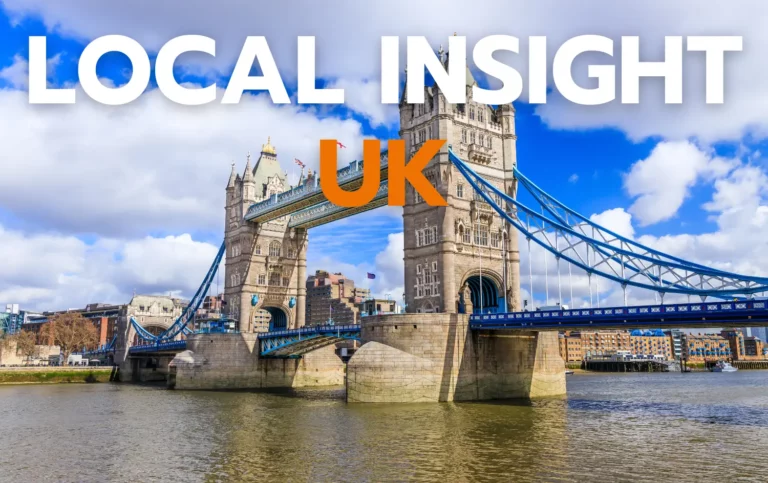UK Market Entry: Quick Facts
- Market size: 6th largest global economy, £243.7B financial services sector
- Investment appeal: 2nd globally for investment attractiveness, 5th on Global Innovation Index
- Trade access: 99 countries and territories with UK trade agreements
- Survival reality: 47% of startups survive to year 3
- Key challenge: 28% of businesses cite economic uncertainty; 47 regulatory touchpoints
- Success factor: Companies perceived as local achieve 2-3× higher success rates
- Critical timeline: 3-6 months to first client (SME), 6-12 months (enterprise)
Why the UK Market Still Matters for International Expansion
The UK market remains the world’s sixth-largest economy, but that’s not why companies should focus here. What matters is the £243.7 billion financial services ecosystem that creates sophisticated demand across every industry—and two-thirds of those jobs sit outside London.
The UK offers unique strategic advantages that separate it from other European markets. London alone has 9 million inhabitants—more populous than Scotland or Wales—creating concentrated market density. The country ranks second globally for investment attractiveness and fifth on the Global Innovation Index, demonstrating sustained business confidence.
Brexit changed the regulatory framework, not the fundamental opportunity. Companies willing to navigate enhanced requirements benefit from reduced uncertainty and £4.3 billion in government backing for committed market entrants. The UK has developed one of the broadest trade agreement coverages with 102 countries, creating systematic advantages for companies that commit to proper market entry rather than testing approaches.
Understanding the UK Market and Cultural Differences
Before choosing your market entry strategy, you need to understand what makes the UK market unique beyond the shared language. This foundation determines whether your approach will succeed or become an expensive learning experience.
The Market Reality: Sophisticated and Selective. Only 47% of UK business startups survive to year three, and current conditions are more challenging. 28% of UK businesses report economic uncertainty as their primary challenge, with competition at 22%—the highest since tracking began. Consumer preferences have shifted toward highly selective purchasing across both retail and B2B sectors.
Key Sector Opportunities for Market Entry: Five sectors dominate UK market opportunities and demonstrate the sophistication required:
- Financial Services: HSBC, Citi, and fund management companies drive sophisticated B2B demand
- Manufacturing: 8% of UK employees, including automotive leaders like Rolls-Royce, JCB, and BAE Systems
- Technology: More unicorns than France and Germany combined, with blockchain, cybersecurity, and fintech leaders like Revolut
- Life Sciences: AstraZeneca, GlaxoSmithKline, with NHS as vital buyer providing large, secure contract opportunities
- Retail/E-commerce: UK leads Europe in e-commerce adoption, with companies like Ocado and ASOS setting global delivery standards
Cultural Intelligence That Impacts Business Success English is shared, but business expectations are distinctly British. UK business culture requires understanding indirect communication styles—partners often won’t directly state they’re uninterested in opportunities. You need to manage this indirect opposition through cultural awareness.
Business relationships take time to develop, even though partners expect pragmatism, economic viability, and reliability. People typically work 9-5 with 30-minute lunch breaks, first-name basis interactions are standard even in initial meetings, and “pub culture” plays an important role in team building and business relationship development.
Pricing Strategy Beyond Currency Conversion CPI rose 3.8% while 30% of businesses report input cost increases but only 11% increase prices. Regional market trends compound complexity—North West faces 31% input increases versus London’s 27%.
Simple currency conversion ignores volume discounting expectations. 94% of UK consumers hold loyalty schemes with perpetual bundling preferences that affect both retail and B2B purchasing patterns.
Why Most Market Entry Strategies Fail
Understanding these market realities explains why passive approaches consistently fail. Here’s the typical failure sequence we observe:
- Choose distribution strategies without accountability frameworks
- Translate materials without understanding cultural differences
- Attend trade shows without local partnership follow-up capability
- Wonder why this “English-speaking market” isn’t delivering expected results
UK goods exports fell £3.4 billion in Q2 2025 while companies with passive strategies struggled. Meanwhile, those with systematic local operations captured available growth opportunities.
The lesson: UK market entry requires handling 47 regulatory touchpoints while building credible local presence. Most companies underestimate this complexity when approaching this sophisticated target market.
Key Strategies for UK Market Entry: Options and Budget Reality
Each approach works when properly executed and matched to business circumstances. Here’s when to use which strategy, with realistic investment expectations.
Direct Export Sales: Initial Market Research
When it works: Early validation with existing contacts who already know your product or service Budget expectation: 15-20 consulting days over 3-4 months for systematic market validation Reality check: 74,025 business closures in Q2 2025 occurred largely among businesses without committed local presence Critical success factor: This must be supported by a dedicated approach and effective management of the customer or partner relationship, or there is a risk of being marginalized, forgotten, and replaced by another supplier.
Partnership with Local Business: Navigate Established Networks
When it works: UK retail, defense, aerospace, specialized B2B sectors with established supply chains Budget expectation: 15-20 consulting days for systematic partner identification, long-list development, short-list creation, and introduction facilitation Requirements: Must demonstrate clear competitive advantage in highly competitive markets plus substantial resource commitment Success pattern: 1,170 new defense contracts via sourcing in 2024/25 went to committed partners who understand market requirements
Strategic Partnership for Market Penetration:
Understanding Regulatory Framework
When it works: Regulated sectors requiring local credibility or where laws and regulations considerations apply Budget expectation: Higher investment due to legal complexity and due diligence requirements Complexity warning: Mandatory CMA notification for £25M+ joint ventures with enhanced scrutiny Key dependency: Success depends heavily on partner selection and understanding cultural differences—both sides must commit substantial resources
Setting Up a Business: Long-term Market Commitment
When it works: Companies ready for 2+ year commitment with significant opportunities for R&D advantages Budget expectations:
- Company incorporation and legal setup (immediate costs)
- Sponsor license: £5,000 plus £2,000-5,000 per employee visa
- Business developer (3-5 years experience): £40-42,000 annually
- Senior business developer: £80,000-150,000 annual package
- Processing time: 1 month for a sponsor license, 1-2 months for employee visas
Set up reality: “Appropriate address” + registered email + lawful purpose requirements mean you need professional setup when launching a product. Funding opportunity: 20% R&D tax credits available but requires genuine UK R&D activity.
Acquisition Strategy: Immediate Market Position.
When it works: Global expansion where speed requirements outweigh cost considerations and cultural integration risks. Due diligence complexity: 2.73 million potential targets but regulatory scrutiny for sensitive sectors adds 3-6 months to timelines. Integration challenge: Business culture differences often surprise companies entering the UK market
Don’t choose market entry strategies based on budget alone—match your approach to control requirements, timeline, and regulatory environment.
Execution Strategy: Building Your Presence in the UK Market
The UK market doesn’t give you time to “figure it out locally.” Here’s the infrastructure work that determines success or failure, and why company incorporation takes just 24 hours but real market credibility requires systematic planning.
Legal Infrastructure (Weeks 1-2) Companies House now requires “appropriate addresses” where documents reach responsible parties. You can establish a private limited company in 24 hours with minimal capital (£1 if required), but virtual offices must meet new criteria, while PO boxes are no longer valid.
Business Operations Compliance (Weeks 3-4) Off-payroll working rules require Status Determination Statements for medium/large clients. Payroll setup takes seven days once your company exists, but employment law complexity requires professional infrastructure.
Market Credibility and Workforce Access (Weeks 5-8) The UK attracts international talent as the first European and second global destination for international students, with Cambridge and Oxford ranked in the top 10 universities worldwide. However, since Brexit, non-UK employees need visa sponsorship.
Government procurement increasingly favors established UK operations. “Reverse pitch” exercises require local delivery capability, not just remote proposals.
The pattern we see: companies that look local get treated as domestic partners. Those that don’t face longer sales cycles, payment delays, and exclusion from certain opportunities.
Procurement Requirements SME procurement policies require formal competition processes even for smaller contracts. MOD awarded 560 new SME contracts worth £941M, but zero went to informal approaches.
Large Business Compliance data shows £15.8 billion yield from professional operations—cooperative compliance requires a systematic setup from day one.
What to Track in Your First 12 Months
Most companies track vanity metrics instead of indicators that correlate with successful market entry. Here’s what actually matters.
Qualified Lead Generation from UK-Specific Efforts Target ranges: 15-25 monthly for B2B services, 5-10 for complex manufacturing Market context: Only 12% of businesses reported turnover increases in August 2025—focus on resilient sectors Avoid targeting: Education (31% expect decreases) and accommodation/food (21% expect decreases)
Speed to First UK Client Realistic benchmarks: 3-6 months for SME-focused strategies, 6-12 months for enterprise sales. Reference point: Government supported 376 exporters in 2024-25, 74% SMEs achieving systematic client acquisition
Most Critical: Local vs International Market Perception Assessment questions: Are you offered local payment terms? Included in UK-only procurement categories? Invited to domestic business networks? Eligible for government support programs?
Companies perceived as local partners achieve 2-3x higher success rates in client acquisition and preferential treatment in competitive situations.
Partnership and Export Opportunities Within 6 Months Target: 20-30% of clients providing referrals or introductions.Success correlation: Companies achieving this threshold show 2.5x higher survival rates in government export programs
Current High-Demand Sectors for Foreign Investment. Based on recent investment patterns, these sectors show the strongest demand for international entrants:
- Technology and AI: Major investments from companies like Nvidia, with government AI partnerships
- Renewable Energy and Clean Tech: Substantial government infrastructure investment
- Life Sciences and Healthcare: NHS contracts provide large, secure revenue opportunities
- Advanced Manufacturing and Logistics: Continued investment across supply chain optimization
The most important question for any successful market entry strategy: “Are UK prospects treating you as a local business or overseas supplier?” Everything else flows from this perception.
How ALTIOS Approaches Successful UK Market Entry
International expansion fails when companies underestimate UK complexity while overestimating execution capability.
The Three-Pillar Planning Framework. Every UK roadmap requires balancing:
- Ambition: Clear vision, objectives, revenue targets, timeline
- Resources: Dedicated people, budget, timeline objectives
- Market Accessibility: Market size, competitors, regulations, ecosystem understanding
Our Market Understanding Methodology. We systematically assess the market environment, size, regulation, competition, and the complete ecosystem before operational work begins.
Testing Market Receptivity Before Investment. We test receptivity through systematic conversations with potential clients, partners, and industry experts to confirm differentiating factors, identify added value, discover barriers, and strengthen sales approach.
Strategic Pathways
- Indirect Strategy: Partnership-based entry (lower investment, reduced control)
- Direct Strategy: Subsidiary establishment (higher investment, maximum control)
- Incubation: ALTIOS manages a subsidiary while you hire salespeople
What We Handle vs. What You Control ALTIOS coordinates: Regulatory compliance, legal obligations, employment law, government programs, market studies, subsidiary management.
We support and You control: Market execution, customer relationships, pricing strategy, business development
ALTIOS does not guarantee market outcomes—that depends on execution and market conditions. We ensure process quality, regulatory compliance, and systematic infrastructure for companies committed to proper UK market entry.
The UK rewards systematic approaches over testing strategies. We help serious companies execute properly from day one.
FAQ Section
What are the main market entry strategies for the UK?
Four primary strategies exist: Direct Export Sales (15-20 consulting days over 3-4 months for initial validation), Strategic Partnerships (for defense, aerospace, specialized B2B sectors), Direct Subsidiary (2+ year commitment requiring £5,000 sponsor license plus £2-5K per employee visa), and Acquisition (2.73 million potential targets with 3-6 months added timeline for sensitive sectors). Each strategy suits different business circumstances, control requirements, and timelines.
How long does it take to establish operations in the UK?
Company incorporation takes 24 hours, but credible market operations require systematic planning over weeks 1-8. Legal infrastructure (weeks 1-2) includes Companies House registration with “appropriate address” requirements. Business compliance (weeks 3-4) covers payroll setup and employment law. Market credibility (weeks 5-8) involves workforce access and establishing local presence. Sponsor license processing takes 1 month; employee visas take 1-2 months.
What are the costs of setting up a UK subsidiary?
Direct costs include: Company incorporation and legal setup (immediate), sponsor license £5,000, employee visas £2,000-5,000 each, business developer salaries £40-42,000 annually, senior business developer £80,000-150,000 annually. Processing timeline: 1 month for sponsor license, 1-2 months for employee visas. Companies also benefit from 20% R&D tax credits for genuine UK R&D activity.
Why do most UK market entry strategies fail?
Passive approaches fail through: choosing distribution without accountability frameworks, translating materials without cultural understanding, attending trade shows without local follow-up capability. 74,025 business closures occurred in Q2 2025 largely among businesses without committed local presence. UK market entry requires handling 47 regulatory touchpoints while building credible local presence—complexity most companies underestimate.
What sectors offer the best opportunities in the UK market?
Five key sectors dominate: Financial Services (HSBC, Citi, fund management driving B2B demand), Manufacturing (8% of UK employees, including Rolls-Royce, JCB, BAE Systems), Technology (more unicorns than France and Germany combined, blockchain, cybersecurity, fintech leaders), Life Sciences (AstraZeneca, GlaxoSmithKline, NHS contracts), Retail/E-commerce (UK leads Europe in e-commerce adoption). Current high-demand areas include Technology/AI, Renewable Energy, Life Sciences/Healthcare, Advanced Manufacturing
How important is being perceived as a “local” company?
Critical. Companies perceived as local partners achieve 2-3× higher success rates in client acquisition and preferential treatment in competitive situations. Government procurement increasingly favors established UK operations. Companies that look local get treated as domestic partners with local payment terms, inclusion in UK-only procurement categories, invitations to domestic business networks, and eligibility for government support programs. Those that don’t face longer sales cycles, payment delays, and exclusion from opportunities
What should I track in the first 12 months?
Track: Qualified lead generation (15-25 monthly for B2B services, 5-10 for complex manufacturing), Speed to first UK client (3-6 months SME-focused, 6-12 months enterprise), Local vs international perception (payment terms, procurement inclusion, business network invitations), Partnership opportunities (target 20-30% of clients providing referrals—companies achieving this show 2.5× higher survival rates). Avoid vanity metrics; focus on indicators correlating with successful market entr








